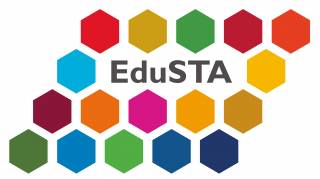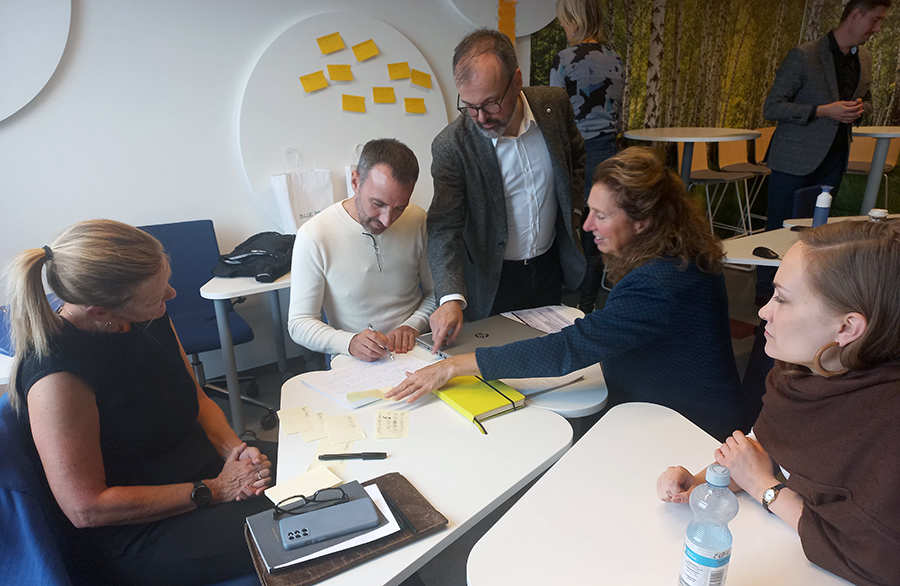Participants shared their thoughts in duo’s about the overarching EduSTA learning network goal and why and what they hope to contribute to it:
“We have a lot of big questions ahead of us: How will we collaborate? How do we go about the content of the badges? How do we make it relatable for all educators? But these questions bring us excitement!”
What do we need to do and what do we need to be able to do it?
The focus then shifted towards the introduction on the actual design challenge and the overarching related question: how can we, as members of a learning network, support teachers in the recognition, acquisition and transfer of their teacher competences for education for sustainability through the development of digital open badges and supportive learning pathways.
To empathize with the needs of the teachers and the contexts EduSTA is designing for, each national partner delivered a short presentation on needs for teacher development in their context, addressing the educational level that they will focus on, the current ESD policy climate and ESD-teacher development needs.
The participants responded individually on each partner presentation in the chat, resulting in reflections and questions, f.e.
“Time constraint is an interesting issue. Is there a different way to look at this challenge regarding time, tasks, organization of work, timetable, teamwork and networking so that addressing sustainability is not another thing to add in our list of tasks?
A further elaboration on the design challenge explained the competence areas and the design process of the competence based digital open badges. Summaries in the chat of the breakout sessions report that there is a need to create more understanding of the presented competence areas and how to translate them into badges that serve teacher practices, since it can be a “fine line between stimulating practice and certification stickers”.
It is also stressed that the badge designs should benefit all teachers, regardless of context or teaching level and that this contextualization can very well be part of the competence demonstration and documentation. The matter of interconnectedness of the competence areas is addressed as well and the need to think further on this.
The chat responses also point out the need for help in organizing:
“What will enable us? Common language, common concepts to be able to collaborate and have a shared idea and goal.”, “We need a little more clarification about the framework and the words we are using so we understand them the same”.
“We also thought that the development groups will need some guidance in how to get started and how to proceed.”
The participants expect that the process and tools offered by work package leaders Hanze and TAMK will be really helpful for them.
How to proceed?
The final phase of the meeting was allocated to the badge design teams for introductions and first practical arrangements. In the report to plenary, feelings of recognition within a team were shared and appreciation for the diversity of the group, with common points of interests and valuable assets. But also, the sense that the info needs to sink in and that there is some uncertainty and unclearness as well, asking for digestion and structure.
A one minute paper (Stead, 2005) in the chat wrapped up the kick off, bringing about each participant’s most important insight and question at the end of the meeting. In their insights they not only value meeting the other team members and the talents and experience they bring into the process, but also the power of cooperation and creating knowledge together in a good collegial team spirit.
Some express to have gained a better understanding of the project as a whole and underline the need to keep the different contexts in mind. Relatively many insights expressed a certain level of trust regarding the process and the collaboration:
“We are proceeding, and we are going make this together.”
“Even though our context needs and wishes are very different, there is a lot of overlap and commonality to build on!”
“We are going to find our focus in time”.
The questions that were raised by the meeting show a clear need for developmental space. However, the participants wondered how to connect and collaborate within and across the badge design teams in order to share know-how, to create synergy and alignment: How to secure time to get to know each other and learn from each other? “How to create a common understanding about the badges overall?, ”How to share know-how to create badges?”.
Questions referring to the complexity of the task were also raised:
How to manage badges to adapt them to different contexts? How can we take a connected approach? How to be specific in the design of the micro-credentials and how are they related to each other and the shared framework? How are we going to break down badges while keeping the connection among/across them for the macro-badge?
In the upcoming months we will keep you posted on the learning and proceedings that will arise from the design process. So, stay tuned and for all developers involved: we are looking forward to learning from and with you!
Text: Elles Kazemier
Photo: Barbora Jordánová
Additional information:
Elles Kazemier
Senior Lecturer and Researcher Professional Development
EduSTA Project Management, Trainer and Researcher
Hanzehogeschool Groningen
e.m.kazemier@pl.hanze.nl


